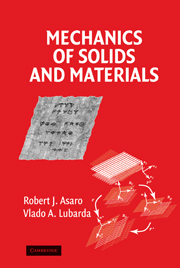Book contents
- Frontmatter
- Contents
- Preface
- PART 1 MATHEMATICAL PRELIMINARIES
- PART 2 CONTINUUM MECHANICS
- PART 3 LINEAR ELASTICITY
- PART 4 MICROMECHANICS
- PART 5 THIN FILMS AND INTERFACES
- PART 6 PLASTICITY AND VISCOPLASTICITY
- 26 Phenomenological Plasticity
- 27 Micromechanics of Crystallographic Slip
- 28 Crystal Plasticity
- 29 The Nature of Crystalline Deformation: Localized Plastic Deformation
- 30 Polycrystal Plasticity
- 31 Laminate Plasticity
- PART 7 BIOMECHANICS
- PART 8 SOLVED PROBLEMS
- Bibliography
- Index
29 - The Nature of Crystalline Deformation: Localized Plastic Deformation
Published online by Cambridge University Press: 06 July 2010
- Frontmatter
- Contents
- Preface
- PART 1 MATHEMATICAL PRELIMINARIES
- PART 2 CONTINUUM MECHANICS
- PART 3 LINEAR ELASTICITY
- PART 4 MICROMECHANICS
- PART 5 THIN FILMS AND INTERFACES
- PART 6 PLASTICITY AND VISCOPLASTICITY
- 26 Phenomenological Plasticity
- 27 Micromechanics of Crystallographic Slip
- 28 Crystal Plasticity
- 29 The Nature of Crystalline Deformation: Localized Plastic Deformation
- 30 Polycrystal Plasticity
- 31 Laminate Plasticity
- PART 7 BIOMECHANICS
- PART 8 SOLVED PROBLEMS
- Bibliography
- Index
Summary
The previous three chapters have laid out some of the basic phenomenological features of plastic deformation in crystals and have developed a mathematical constitutive framework for analyzing crystalline deformation. It is not the purpose herein to provide an exhaustive treatment of particular case studies, in particular through the review of various numerical studies that have been performed, as this is the subject of a rather different volume. We do, however, explore some of the phenomenological implications of the mechanisms and theory developed above vis-à-vis the nature of crystalline deformation. In particular, we will explore the natural tendency of plastic deformation to become highly nonuniform and in fact localized into patterns that can, inter alia, evolve into bands of intensely localized slip, kinking patterns, and the sort of heterogeneous patterns of slip on different systems that were referred to as “patchy slip” in Chapter 27. These examples of localized deformation are important because they often lead to material failure, as well as to the evolution of internal substructure that, in turn, directly influences evolving material response. On the other hand, the analysis of these deformation patterns serves to highlight some rather fundamental aspects of the process of crystalline deformation via the process of slip. This serves to reveal and, in part explain, some of the basic implications of the type of theory we have outlined herein.
- Type
- Chapter
- Information
- Mechanics of Solids and Materials , pp. 557 - 585Publisher: Cambridge University PressPrint publication year: 2006



